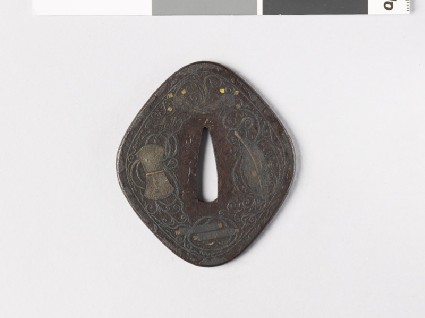Browse: 1142 objects
Tsuba with Indian lotuses and four of the Precious Objects
-
Details
- Associated place
- Date
- 19th century (1801 - 1900)
- Material and technique
- iron, with gold, and with silver wire nunome-zōgan decoration
- Dimensions
- 7.8 x 6.8 cm (height x width)
- Material index
-
processed material › metal › iron,
- Technique index
- Object type index
-
arms/armour › koshirae › kodogu › tsuba
- No. of items
- 1
- Credit line
- Bequeathed by Sir Arthur H. Church, 1915.
- Accession no.
- EAX.10845
-
Further reading
Koop, Albert James, The A. H. Church Collection of Japanese Sword-Guards (Tsuba), 3 vols (Oxford, Ashmolean Museum, 1929), no. 845
Glossary (2)
nunome-zōgan, tsuba
-
nunome-zōgan
Decorative application of metal sheeting (generally of gold or silver) where the iron ground is first cross-hatched and the metal burnished on.
-
tsuba
Japanese sword guard.
Location
-
- currently in research collection
Objects are sometimes moved to a different location. Our object location data is usually updated on a monthly basis. Contact the Jameel Study Centre if you are planning to visit the museum to see a particular object on display, or would like to arrange an appointment to see an object in our reserve collections.
Publications online
-

The A. H. Church Collection of Japanese Sword-Guards (Tsuba)
Rounded lozenge shape; designs in nunome silver wire with gold details: on the front, four Precious Objects (cloves, leaf, scrolls, double axe-head) linked by scrolls; on the back two "Indian lotuses" with the similar scrolls; border and edge with remains of silver numome. Signed (for the decoration): Kumagai ([Japanese text], surname) Yoshiyuki [Japanese text] with kakihan [Japanese text], and (for the iron) Nihommatsu no shin [Japanese text], "retainer of [the Niwa, lords of] Nohommatsu [in Mutsu province]") Hiromoto [Japanese text] Kōfu ni oite ([Japanese text], "in Yedo") jintetsu-dan ([Japanese text], "forged of sword iron").
Kumagai Yoshiyuki was a samurai in the service of the Hosokawa, lords of Higo, about 1800, but the affinities of this guard are with Hizen work rather than with the productions of the Higo Masters (Group XIII), and, of course, are miles away from the Shōzui style (Hamano, Group XLI) in which Wada (pp. 230, 238) says he worked.
© 2013 University of Oxford - Ashmolean Museum

